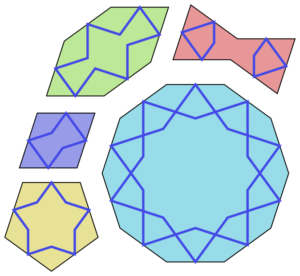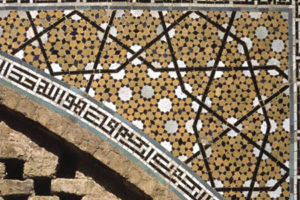The Rediscovery of Islamic Pattern Genius: An Integrated Exploration of the Geometrical, Cosmological, and Cultural Meaning of Five- and Ten-Fold Symmetry in Traditional Islamic Design

In 2007 Peter Lu and Paul Steinhardt demonstrated that the tiling on a 15th century shrine in Isfahan was an example of a quasicrystalline pattern, a geometrical structure that was not understood in the West until the 1970’s. The Radius Foundation is sponsoring a book-length work that will unfold the metaphysical and cosmological meanings of these patterns in five- and ten-fold symmetry, explaining their expressions of a profound understanding of God, His creation, and our place in it.
An Integrated Exploration of the Geometrical, Cosmological, and Cultural Meaning of Five and Ten-Fold Symmetry in Traditional Islamic Design. A Project of the Radius Foundation, Inc.
In the 1970’s, Sir Roger Penrose of Oxford University defined several new sets of aperiodic tiling based on five-fold symmetry. These tile sets can form patterns that are perfectly ordered and yet never repeat, and that contain different expressions of the golden ratio and the property of self-similarity. Much to the amazement of physicists and engineers, these patterns were then found in the molecular structure of certain natural materials, where they became known as “quasi-crystals.” Prior to that time, it was thought that five-fold symmetry could not occur in the arrangement of atoms in solids.
In 2007, Peter Lu, a graduate student in physics at Princeton University, discovered a surprising connection between medieval Islamic tilings in five-fold symmetry and quasi-crystalline patterns.

Working with Princeton cosmologist Paul Steinhardt, Lu first uncovered the hidden technique by which medieval Islamic craftsmen constructed patterns in five-fold symmetry: they used a set of tessellating tiles as hidden templates. This set of tiles, which Lu and Steinhardt dubbed “girih tiles,” has the same mathematical properties as the aperiodic tiling sets that Penrose defined hundreds of years later. The underlying girih-tile structure of the Islamic patterns is veiled, however, because the lines of the finished patterns are not taken from the edges of the girh tiles, but from lines inscribed on them.
The tiling at the far left, from the Green Mosque in Bursa, Turkey, is an example of a pattern constructed from girih tiles. The placement of the girih tiles is shown in the diagram next to it.

Steinhardt and Lu published their discoveries in the February 23, 2007 issue of Science magazine in an article entitled “Decagonal and Quasi-crystalline Tilings in Medieval Islamic Architecture.” The article received international attention—not only because they had rediscovered the technique used so effectively by the medieval craftsmen, but because they showed that girih tiles form a previously unknown Penrose set. Steinhardt and Lu further showed that medieval Islamic craftsmen had a sophisticated understanding of the mathematical properties of this tiling set, even constructing true quasi-crystalline tiling patterns and highlighting their expressions of self-similarity. The craftsmen achieved this feat of geometry hundreds of years before quasi-crystalline patterns were understood in the West. Discover magazine ranked Lu and Steinhardt’s discovery #59 in their “Top 100 Scientific Discoveries of 2007” issue.
Yet, beyond the expression of complex mathematics, there are deeper meanings to Islamic tiling patterns: they express the worldview and spiritual insights of the culture and the tradition that created them. More than simply decorations, they are an expression of some of the principles that the culture holds most sacred. Other authors have written on the cosmological meaning of the numbers five and ten and the symmetry and patterns associated with those numbers. But no one has yet explored the metaphysical and cosmological meaning of the quasi-crystalline structure that Lu and Steinhardt have found in different Islamic tiling designs.
A spandrel from the Darb-i Imam Shrine in Isfahan. The pattern is formed of small girih tiles, and the much larger girih-tile pattern is highlighted in dark lines by the craftsmen. What cosmological meaning is expressed here? (Photo from Steinhardt and Lu’s article)
The Radius Foundation welcomes proposals for an integrated work, based on these traditional Islamic patterns in five- and ten-fold symmetry, whose structure we have only recently begun to understand. This new work would explore these designs as sacred art that expresses metaphysical and cosmological meanings. We believe that the geometrical structure and cosmological meaning of these designs can be seen more clearly in light of each other. This project would unfold the metaphysical and cosmological meanings of these patterns in five- and ten-fold symmetry, explaining their expressions of a profound understanding of God, His creation, and our place in it.

